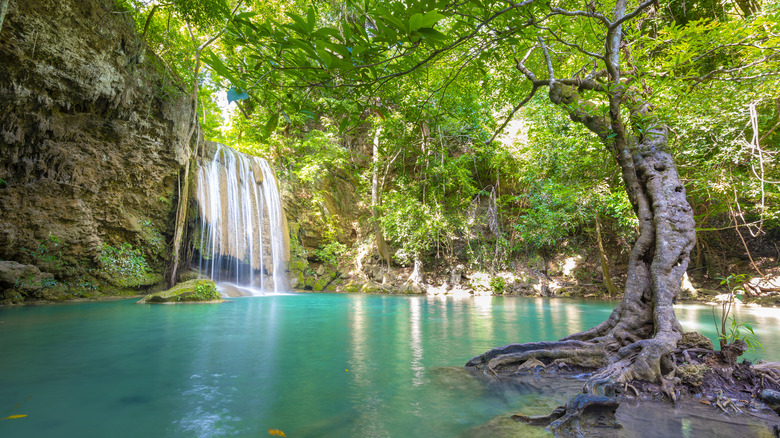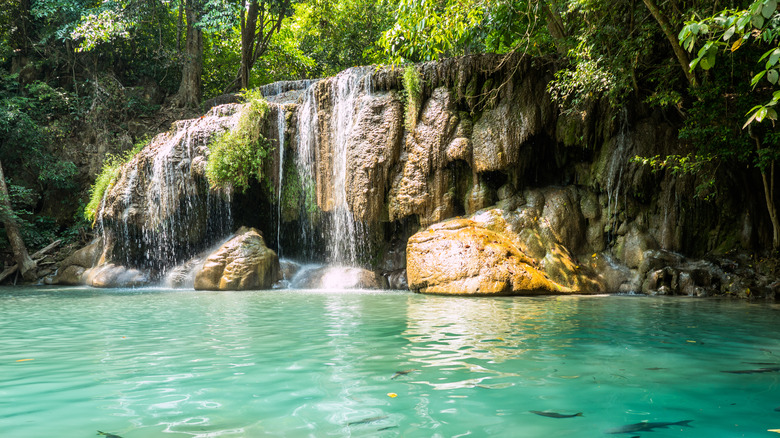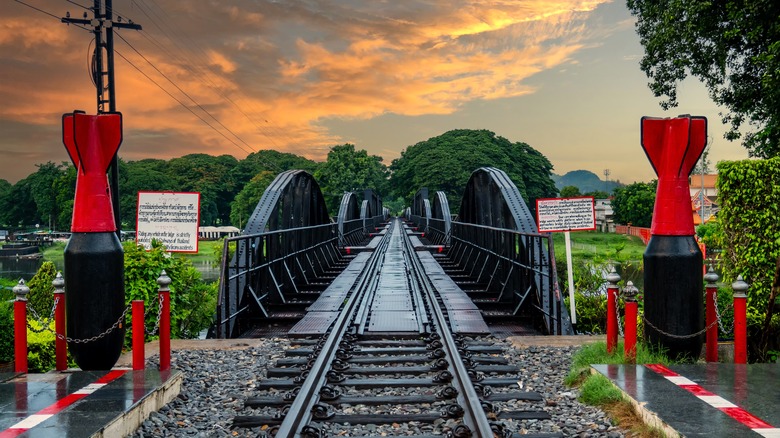This National Park In Thailand Is A Tropical Hidden Gem Of Waterfall Swimming Holes
While many vacationers flock to destinations like Phuket and Koh Samui (some of Thailand's top 10 islands to visit), the mainland offers plenty to explore as well, such as friendly locals, incredible food, and fascinating history. Thailand is home to some stunning wonders that are less frequented by tourists. Venturing away from popular areas like Bangkok opens up a new world of lesser-known national reserves. One such park is Erawan, a natural gem perfect for families, solo travelers, or couples.
The forested park is famed for its seven-tiered waterfall, which visitors can reach by ascending through a lush green jungle surrounded by limestone pools and bubbling rivers. Each level offers breathtaking scenes of cascading water — some falls rush powerfully while others flow in a gentle trickle. The top tier is said to resemble the three-headed white elephant Erawan in Hindu mythology, from which the park gets its name. The distance from the bottom to the top is just over a mile; the route climbs up stairs and can be steep in some areas despite being well-paved. It's not recommended for those with mobility issues, and you should bring sensible walking shoes.
You'll want to enjoy a refreshing dip in the water, so be sure to bring swimwear and towels. Visiting Erawan National Park doubles up as a spa day of sorts, as some of the pools are home to flesh-eating fish that will nibble on dead skin cells. As you enter the water, these curious fish primarily approach your feet, giving you a pedicure and free exfoliation — it feels like a sharp tickle but is a unique and painless sensation.
What to expect from Erawan National Park
Erawan National Park is incredibly well maintained, and the Thai government takes great care to preserve the stunning natural environment. For safety reasons, swimming is not allowed in some bodies of water. In areas where you can take a dip, wearing a lifejacket is mandatory. Park rangers are stationed throughout the park to ensure compliance, and lifejackets can be rented near the first waterfall — just don't forget to bring some cash with you. Insect repellent is also a must to avoid pesky mosquitoes.
Erawan's rugged natural beauty, verdant foliage, and abundant water sources make it a wildlife enthusiast's wonderland. The park is a birdwatcher's paradise; over 120 species have been spotted, like owls, bee-eaters, woodpeckers, and kingfishers. Many tourists visit the country to ride elephants, but this area is often too busy with human activity to encounter larger mammals — although, you may want to think twice before visiting an elephant camp in Thailand. Crab-eating macaques are almost guaranteed to be spotted and can be extremely mischievous or sometimes aggressive if you get too close to their young. Be cautious with your belongings, as the monkeys are known to steal items.
The park is open year-round, and tickets can be purchased on the day of your visit. There are a few cafés and restaurants, and many enjoy the picnic tables by the water's edge. The park is strict about reducing waste, as food and drinks are not allowed beyond level two. There is a checkpoint where you are required to pay a deposit per plastic bottle, which is refunded when you return.
Getting to Erawan National Park
The closest town to Erawan National Park is Kanchanaburi, which is in a lush, tropical, mountainous province in western Thailand of the same name. Using Kanchanaburi as a base is an excellent idea, as there are several ways to reach the remote park, located around 40 miles away. The most affordable way to get to Erawan is by public bus, which takes roughly an hour and a half. It's highly recommended to arrive early to avoid overcrowding. Private transportation can also be arranged from both Kanchanaburi and Bangkok, making visiting the park seamless, albeit more expensive. These services also offer routes to the nearby Hellfire Pass, another major draw for international visitors, allowing you to add more sites to your itinerary.
Take time to explore the historically significant sites in Kanchanaburi itself. The town is located at the meeting point of the Khwae Noi and Khwae Yai rivers, adding to the area's stunning natural beauty. It centers around the Death Railway and the Khwae River Bridge, one of the most famous sites from World War II. The bridge, immortalized in the 1957 film "The Bridge on the River Kwai," is still operational for tourists. There are also walking platforms on either side of the tracks for foot traffic. It's a spectacular place to catch the sunset over the river. For travelers who want to avoid the overcrowded Bangkok further, Pattaya City is an underrated beach destination.


